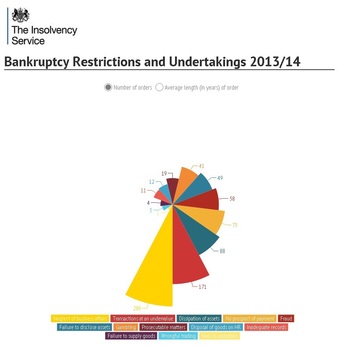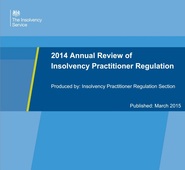 Bankruptcy provides debtors with the opportunity for a fresh start by wiping out most of their debts but it also brings with it significant restrictions, which usually last for one year. Official receivers investigate each bankruptcy to determine what caused the debtor to lose control of their finances. Where it is found that reckless or dishonest behaviour was a factor the official receiver will apply to the court or seek an undertaking from the bankrupt to extend the period during which the bankrupt is subject to bankruptcy restrictions. Bankruptcy restrictions orders and undertakings prevent individuals from accessing credit without disclosing their status and place restrictions over their ability to trade under a different name, protecting the public from further dishonest conduct by that individual.
The Insolvency Service maintains a public database where members of the public can check to see if an individual is subject to a bankruptcy restriction. In 2013/14 812 individuals were subject to extended bankruptcy restrictions for an average period of 5 years. The most common grounds were neglect of business affairs, followed by disposal of assets for less than a fair value or making payments which consumed assets that would otherwise be available for distribution to the bankrupt’s creditors. A fifth of all bankruptcy restrictions obtained last year were for transactions that disadvantaged creditors - depriving them of an estimated £316 million (or an average of £57,562 per case). Other breaches of the law can also lead to extended restrictions being imposed.
Bankruptcy restrictions
In 2014 the court made a bankruptcy restrictions order against Qing Zhao, who ran a take-away outlet, for a period of four years for neglecting her business affairs, including employing five illegal workers in breach of immigration law.
Wajid Hussain, a restaurateur, gave a bankruptcy restrictions undertaking for a period of six years in August 2014 for employing three illegal workers. Mr Hussain had received penalties totaling £18,865 which he failed to pay and which contributed materially to his bankruptcy.
|
 This year marks the
25th anniversary of the Insolvency Service. Since the first Bankruptcy Act was
enacted in 1542 there has followed a chequered and colourful history of how the
law has dealt with debt. It was the passage of Bankruptcy Act of 1883 during
Gladstone’s second government that laid down the foundations of the Insolvency
Act 1986 Act which we operate under today. Gladstone’s President of the Board
of Trade, Joseph Chamberlain, noted for his prowess at debating, described the
purpose of the 1883 legislation as ‘protecting the salvage…diminishing the risk
of wreck…and improving the general tone of commercial morality’: principles
that still guide our modern insolvency regime.
|
On the 12 March 2015, the EU Justice and Home Affairs Council will adopt a revised EC Regulation on insolvency proceedings, first proposed in 2012. The new Regulation, which will for the most part come into force into 2017, marks a significant change in EU insolvency law. The main features of the new Regulation are:
- a broadened scope to include more rescue and pre-insolvency proceedings
- increased court examination of forum shopping cases where debtors and companies relocate within the EU to access a more favorable insolvency processGroup companies are being recognized for the first time and the Regulation provides a framework for cooperation and coordination between courts and office holders
- the interconnection of Member States insolvency registers which will help creditors find information about EU insolvency cases
The main objective of the new Regulation is the development of a rescue culture in the EU to ensure, where possible, that viable businesses are saved and jobs preserved. It also seeks to improve the efficiency of cross-border insolvency proceedings in the EU. The text of the new Regulation can be found here.
The European Parliament is expected to adopt the text in April.
Cypriot
officials working to reform the nation’s insolvency framework are being
assisted by the Insolvency Services’ Senior Official Receiver, David Chapman.
The UK insolvency regime is highly regarded internationally, returning more
money to creditors, quicker and at lower cost, than most other countries.
Reform of its insolvency framework was a condition of the international bailout
Cyprus negotiated with the troika of European agencies and the International
Monetary Fund following the financial crisis it experienced in 2012-2013.
David
Chapman and colleagues from Companies House were invited to visit Cyprus in
2013 as part of a review of its Department of the Registrar of Companies and
Official Receiver. The review reported in December 2013 and made recommendations
on significant changes to the insolvency legislation and associated working
processes. Four bills have so far been presented to the House of
Representatives in Cyprus and the final Bill was recently approved by the
Cypriot Cabinet for introduction. We have continued to provide advice and
assistance, drawing on a range of expertise across the Insolvency Service and
David Chapman will be returning to Cyprus in April 2015 to assist with the
restructuring of the Department’s insolvency section.
 As oversight
regulator in the insolvency sector we scrutinise the recognised professional
bodies who directly authorise and regulate insolvency practitioners, ensuring
that they have the procedures in place to encourage best practice and to deal
robustly with misconduct.
Over the past year we have led work on improving
transparency around the regulatory process and this is the focus on our Annual
Review of Insolvency Practitioner Regulation. This work
includes:
-
publishing professional misconduct sanctions imposed on insolvency practitioners
-
publishing the results of our monitoring of the regulators, including the recommendations we make for improvement and the regulators’ responses. This includes our recent report on the Association of Chartered Certified Accountants.
The review also includes the results of our monitoring of
disclosure requirements in pre-pack deals, showing that full compliance rates
remained at around 78%, with just over 3% of cases being referred to the recognised
professional body for consideration. It is expected that the introduction of a
new statement of insolvency practice for pre-pack deals with independent
scrutiny prior to sale will lead to higher standards in future.
|
-
MPs have approved plans to increase the bankruptcy creditor petition limit to £5000 from 1 October
2015.
-
Parliament is expected to approve the Small
Business, Enterprise and Employment Bill which strengthens the director disqualification process and reforms insolvency
law and the Deregulation Bill which removes unnecessary red tape in insolvency proceedings before it rises
for the general election later this month.
- A new revised draft of the Statement of Insolvency Practice for pre-pack administrations (SIP16) addressing the recommendations from the 2014 Graham Review is currently being considered by the Joint Insolvency Committee and is expected to be issued shortly.
Changes to the record keeping
requirements on insolvency practitioners are expected to reduce duplication and
lower costs. From 1 October 2015 information such as details of appointments,
dates of creditors’ meetings and distributions to creditors no longer need to
be kept separately from other case records. We consulted with insolvency
practitioners and others on this change as part of the government’s Red Tape Challenge. It is estimated that the
change will deliver annual savings to creditors of over £3 million annually.
We are making
improvements to our estate accounts services for insolvency practitioners by
revamping our ISCIS online system to provide insolvency practitioners with more
options when needing to extract data. Furthermore, from 1 April 2015 we are
halving our payments target and committing to clearing ISA payment requisitions
within two working days. You can download further information here.
We
measure the confidence that creditors, business, insolvency practitioners and other stakeholders have in our
investigation and enforcement regime each year. In 2014 overall confidence rose
by four points to 73 per cent, building on annual increases over the previous
four years. In February the agency was
re-accredited with the Customer Service Excellence standard. The standard
provides an in-depth and independent assessment of areas that are a priority
for customers. The assessor noted two areas in particular where progress has
been made recently:
- customer insight - we are building our understanding
of our key customer and stakeholder groups and undertaking regular user
research to develop all of our new digital services
- timeliness and quality of service.
During the formal general election campaign in common with other government departments our communications activities will be restricted. We will not be posting to our Twitter account or to our website. We will continue to update the Individual Insolvency Register and the register of disqualified company directors as usual. Official insolvency statistics will also still be published.
We’ve launched a series of podcasts to keep you informed about our activities and developments in the world of insolvency. In our first podcast Nick Howard focused on changes to insolvency practitioner regulation and our role as the oversight regulator for the industry. This month we are talking to Senior Official Receiver, Dave Chapman, about the biennial review of insolvency practitioner rotas. You can listen to both episodes on our SoundCloud and YouTube pages.
29 April: Insolvency statistics, January to March 2015 published.
In late spring we will begin publishing a new quarterly Official Statistics release, Insolvency Service Enforcement Outcomes, which will provide information on the number of director disqualifications, public interest winding up orders and bankruptcy and debt relief order restrictions. The first edition will cover outcomes achieved between January and March 2015. For more information, or would like to be notified when the new statistics are published, contact statistics@insolvency.gsi.gov.uk.
|